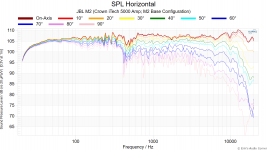Yea, looks like they remedied the compliance issue between the cone/surround (or, what I assume was the issue).
Interestingly, there is now a small "step" in the G-1 version.
Man, this kind of stuff is so exciting to me. I've been wanting to switch gears on my channel/website and start focusing on true DIY designs that I can share with the public but I'm so busy with other speakers that I just haven't cleared everything else. Maybe once I do I will/can focus on trying to make an 4367 clone? Or, if someone out there is really interested in partnering with me I'm happy to handle the measuring part.
Ideally, I'd like to start with a flat pack that is easily accessible by everyone who can order from PE. Maybe start with their 2 or 3cuft enclosures and start building the design based on that. That way you don't absolutely have to have tools to build the speaker beyond a screwdriver and drill.
So true and if you want to do a "real clone" good luck on the parts especially the waveguides. I was surprised you could get all of the M2 minus the cabinets and vents but that may have dried up with both drivers on order. Time will tell!Jeez, we do have tons of 15"+CDhorn diy projects already. But the devil is in details! I just read the white paper of 4367 and I started to understand the price tag of these...
There are so many possible 15" and CD combinations you can certainly see why there are so many and so popular. It's time tested combo!
Rob
Honestly, if I were going to DIY this same speaker, I'd go active. I'm not saying it's entirely necessary. But if you can afford the extra channels of amplification (which really don't need to be high powered given the sensitivity) then you can do some really good work (lower crossover point with steeper slopes, minor EQ adjustment, season to taste, etc) with a miniDSP ... or if you want to get super fancy, the DEQX.
Honestly, you've kind of given me some motivation here... might be a worthwhile project video in the future (when/if I ever get the free time!).
I think it would be interesting to try and scale it down. The JBL 708P seems to be a bit "compromised" because the enclosure is so small.
Mabat just released a new version of ATH that allows us to simulate the enclosure, and I'm eager to see if it would be possible to improve upon the 708P by using a larger baffle.
Then again, this has been something I've been tinkering with for seventeen years lol. When I bought my Gedlee Summas, my original plan was to actually get the smaller version of it. The reason I bought the Summas was because the waiting list for the smaller speakers was months long and I was impatient.
Since we know the crossover shape of the 4367, it shouldn't be too difficult to sort things out:
I'm picturing something like a B&C 8NDL51 combined with an Eminence N151M. With the passive crossover that would be about $1000 a pair, about half as much as cloning a 4367.
I'm not opposed to spending $2K on a set of speakers but I'm wary of having something as big as the 4367 in my living room. Also, I'm currently running a three channel set up and that's a lot of speakers.
interesting how Erin says narrowing of the tweeter may be the reason he likes it. how is a collapsing polar response a quality in any way?
Pretty sure I gave more rationale for that in the video. I know I did here.
I loaded up these diagrams of the JBL 4367 to make some estimates of the cabinet and components:
- The waveguide is about 20" wide x 9" tall
- The woofer is 15" in diameter
- The center to center spacing of the woofer and tweeter is 15"
- The cabinet dimensions are 37-1/16" x 22-1/16" x 16-3/4" (941mm x 560mm x 425mm)
- The chamfer on the front of the cabinet appears to have a radius of one inch
Attachments
Obviously the various JBL monitors share common DNA, and it is particularly obvious with the JBL 4367 and the JBL 708P.
In many respects, the 708P is a miniature version of the 4367.
Here's a pic where I shrunk the 4367 by 50%, to show how the dimensions compare.
In many respects, the 708P is a miniature version of the 4367.
Here's a pic where I shrunk the 4367 by 50%, to show how the dimensions compare.
Attachments
Obviously the various JBL monitors share common DNA, and it is particularly obvious with the JBL 4367 and the JBL 708P.
In many respects, the 708P is a miniature version of the 4367.
Here's a pic where I shrunk the 4367 by 50%, to show how the dimensions compare.
Your right they all do, even the inexpensive near fields take a look at the 308Mk 2 measurements. I use a pair in my office with a sub and they are very nice. Those 4367 voltage drives are not really useful once you start changing compression drivers and horn's/waveguides. As soon as you change either the basic crossover format can work but the notch filters and attenuation will have to be redesigned to get it right.
Rob
https://www.audiosciencereview.com/...ds/jbl-308p-mkii-studio-monitor-review.17338/
I ran out of time to edit the previous message. Here was my edit:
Obviously the various JBL monitors share common DNA, and it is particularly obvious with the JBL 4367 and the JBL 708P.
In many respects, the 708P is a miniature version of the 4367.
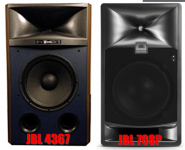
Here's a pic where I shrunk the 4367 by 50%, to show how the dimensions compare.
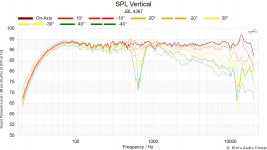
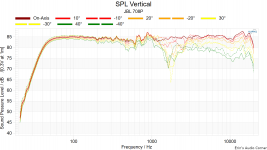
Here are the vertical polars of the JBL 4367 and the JBL 708P.
In the vertical polars, it's obvious that the smaller size of the 708P has moved the off axis dip an octave higher. There are a few things that may not be as obvious. The center-to-center spacing of the 708P is a full wavelength at the crossover frequency. The center to center spacing of the 4367 is eight tenths of a wavelength at the crossover frequency.
I wish that I could point to one of these designs and declare that they're superior, but there's no obvious winner:
* The 708P, with it's wider vertical beamwidth, has a smoother transition from the woofer to the tweeter.
* The 4367, with it's narrower vertical beamwidth, will be less likely to trigger reflections off the floor and the ceiling. From 2khz to 20khz, the JBL 4367 is radiating about half as much energy into the floor and the ceiling than the JBL 708P.
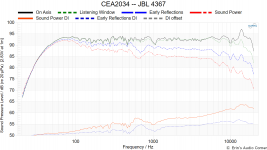
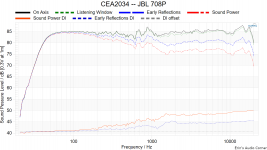
Looking at the spinoramas, both of them have a lot to like. The 4367 goes lower but the 708Ps are smoother.
Obviously the various JBL monitors share common DNA, and it is particularly obvious with the JBL 4367 and the JBL 708P.
In many respects, the 708P is a miniature version of the 4367.

Here's a pic where I shrunk the 4367 by 50%, to show how the dimensions compare.


Here are the vertical polars of the JBL 4367 and the JBL 708P.
In the vertical polars, it's obvious that the smaller size of the 708P has moved the off axis dip an octave higher. There are a few things that may not be as obvious. The center-to-center spacing of the 708P is a full wavelength at the crossover frequency. The center to center spacing of the 4367 is eight tenths of a wavelength at the crossover frequency.
I wish that I could point to one of these designs and declare that they're superior, but there's no obvious winner:
* The 708P, with it's wider vertical beamwidth, has a smoother transition from the woofer to the tweeter.
* The 4367, with it's narrower vertical beamwidth, will be less likely to trigger reflections off the floor and the ceiling. From 2khz to 20khz, the JBL 4367 is radiating about half as much energy into the floor and the ceiling than the JBL 708P.


Looking at the spinoramas, both of them have a lot to like. The 4367 goes lower but the 708Ps are smoother.
Still can't help thinking that these "knuckled throat" type horns are a morphed version of a multi-cell horn. Would sort of explain the relaxed directivity in the upper registers.
I've done a lot of messing around with the "image control waveguides" (see the "M2 For the Poors" thread)
From what I can see, the 'knuckles' on the Image Control Waveguides are basically a diffraction slot. They allow you to achieve a beamwidth that is wider than a waveguide that deep could normally accomplish. For instance, a 90x90 waveguide that has a diameter of 15" has a depth of 7.5", like this:
If you add a diffraction slot, like in the JBL M2, you can achieve a wider beamwidth. (Note how the M2's beamwidth is about 110 degrees, in the four octaves from 375Hz to 6khz.) The downside is that the knuckles screw up the smoothness of the frequency response:
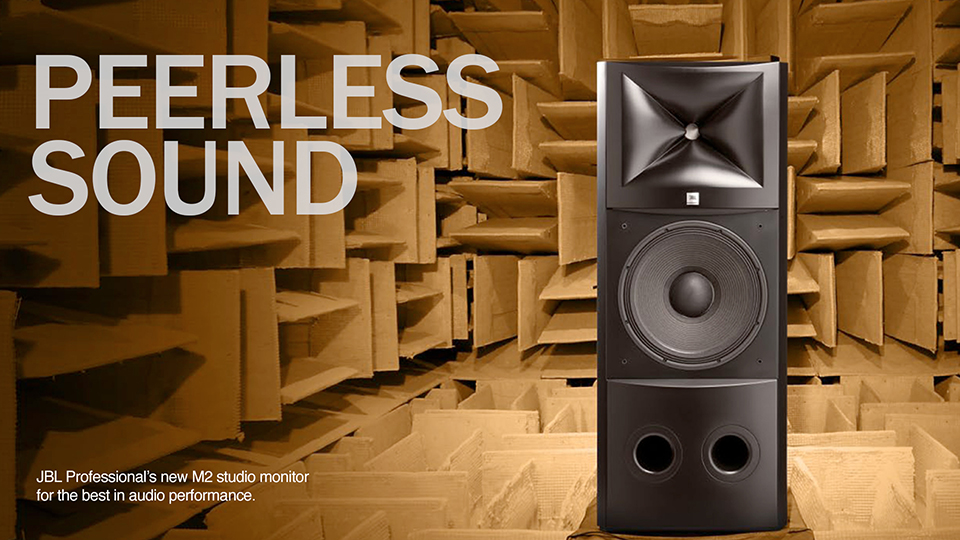

Attachments
^ I'd love to find a pair of those to measure. I did ask Earl a year or two ago and his reply was essentially that he'd have to build them just for me to test them and he didn't really want to go through the trouble. Paraphrasing, of course. I can't blame him. I wouldn't bother, either, if I were him. But if someone lives near Huntsville, Alabama and has a pair (or really, just one) they can loan me for a day or two, I can put it on the KLIPPEL and run some tests for them.
Unlikely you’ll find any Geddes “NA12” models in the wild as I believe I am the only one who owns a pair (and possibly this is the original prototype). The NS15 model you will likely find as he built several of those.
Both of these models are a big upgrade over the Geddes Nathan and Abbey.
The NA12/NS15 both use 18 inch waveguides, neodymium drivers from B&C and updated crossovers as well.
Nearly all the Geddes speakers require subwoofer augmentation as they are sealed designs with little to nothing below 60Hz.
I do have some of his Harper “surround” speakers (8 inch woofer/8 inch waveguide). But…very little response below 100Hz though :-(
Best,
Anand.
Both of these models are a big upgrade over the Geddes Nathan and Abbey.
The NA12/NS15 both use 18 inch waveguides, neodymium drivers from B&C and updated crossovers as well.
Nearly all the Geddes speakers require subwoofer augmentation as they are sealed designs with little to nothing below 60Hz.
I do have some of his Harper “surround” speakers (8 inch woofer/8 inch waveguide). But…very little response below 100Hz though :-(
Best,
Anand.
Stereophile just measured the 4367, enjoy!
https://www.stereophile.com/content/jbl-4367-studio-monitor-loudspeaker
https://www.stereophile.com/content/jbl-4367-studio-monitor-loudspeaker
The first time that I managed to finish building a proper set of Unity horns, back in 2005ish, I immediately noticed that a lot of my recordings are crap.
It was that realization that got me interested in trying to find the best balance between "super analytical loudspeaker" and "forgiving loudspeaker."
I think a lot of that depends on the beamwidth of the speaker. Basically a speaker with narrow beamwidth will tend to sound analytical. Like a giant set of headphones.
The writer of the Stereophile article seems to miss this fairly basic aspect of loudspeaker performance. The author clearly prefers his Altec Valencias. But I think he does readers a disservice by saying that the JBL is inferior.
Another thing I've experienced with my own speakers, is that distortion might make a speaker sound better. It definitely makes it sound louder. For instance, I have a set of Yamaha DXR12s. They sound pretty great. The woofer that it uses is incredibly low tech; it's basically comparable to a $99 Eminence Alpha:
https://www.parts-express.com/Eminence-Alpha-12A-12-Guitar-PA-Driver-290-405
Compares to my Waslo Cosynes, the Yamaha sounds more dynamic. It's possible that this is due to higher efficiency and a larger amplifier. But I've noticed that the Yamaha sounds more dynamic even at 80-90dB.
My hunch is that the Cosynes have lower midrange distortion and this is making them sound more "polite" and "hifi."
Another thing that's absolutely maddening about Stereophile is how they've slowly embraced a bunch of stuff they used to hate. In the 90s they were openly hostile towards JBL speakers and high efficiency speakers in general. Nowadays, they're constantly fawning over fairly cheap/pedestrian designs using cheap high efficiency woofers and inexpensive tweeters.
I'm sure I'm preaching to the choir here, I think a lot of us can see through their reviews.
It was that realization that got me interested in trying to find the best balance between "super analytical loudspeaker" and "forgiving loudspeaker."
I think a lot of that depends on the beamwidth of the speaker. Basically a speaker with narrow beamwidth will tend to sound analytical. Like a giant set of headphones.
The writer of the Stereophile article seems to miss this fairly basic aspect of loudspeaker performance. The author clearly prefers his Altec Valencias. But I think he does readers a disservice by saying that the JBL is inferior.
Another thing I've experienced with my own speakers, is that distortion might make a speaker sound better. It definitely makes it sound louder. For instance, I have a set of Yamaha DXR12s. They sound pretty great. The woofer that it uses is incredibly low tech; it's basically comparable to a $99 Eminence Alpha:
https://www.parts-express.com/Eminence-Alpha-12A-12-Guitar-PA-Driver-290-405
Compares to my Waslo Cosynes, the Yamaha sounds more dynamic. It's possible that this is due to higher efficiency and a larger amplifier. But I've noticed that the Yamaha sounds more dynamic even at 80-90dB.
My hunch is that the Cosynes have lower midrange distortion and this is making them sound more "polite" and "hifi."
Another thing that's absolutely maddening about Stereophile is how they've slowly embraced a bunch of stuff they used to hate. In the 90s they were openly hostile towards JBL speakers and high efficiency speakers in general. Nowadays, they're constantly fawning over fairly cheap/pedestrian designs using cheap high efficiency woofers and inexpensive tweeters.
I'm sure I'm preaching to the choir here, I think a lot of us can see through their reviews.
Has always been the way, well at least since the late 70s. The best you can hope for is that the reviewer admits they are not after fidelity/neutrality and then you can interpret the review. But what do I know, I'm still naive enough to think that a speaker can't be too accurateThe writer of the Stereophile article seems to miss this fairly basic aspect of loudspeaker performance. The author clearly prefers his Altec Valencias. But I think he does readers a disservice by saying that the JBL is inferior.
I am woefully ignorant on the details, so please forgive me if this question is way off base, but how do these designs compare to Parham's 4pi speakers? He talks a lot about "constant directivity" but I think that may be different from what these JBL horn designs are doing?
I checked Erin's site in the hope that he had reviewed the 4pis, as I've been wanting to build a pair for years but haven't seen enough objective analysis to feel comfortable pulling the trigger. If you brilliant gents come up with a design, I might be interested in being a guinea pig builder. No flat pack needed, as the woodwork is the part I actually understand.
I checked Erin's site in the hope that he had reviewed the 4pis, as I've been wanting to build a pair for years but haven't seen enough objective analysis to feel comfortable pulling the trigger. If you brilliant gents come up with a design, I might be interested in being a guinea pig builder. No flat pack needed, as the woodwork is the part I actually understand.
- Home
- Loudspeakers
- Multi-Way
- Highly Asymmetrical Waveguides
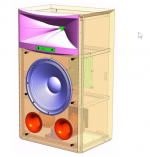
![2022-04-09 08_32_35-Xara Photo & Graphic Designer - [Untitled11 _].png](/community/data/attachments/950/950882-bdaafd728d330585057a4bd5d2db495c.jpg)




